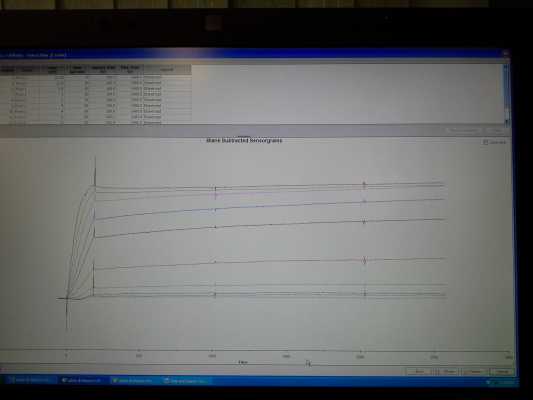This forum is intended for questions about kinetics, Surface Plasmon Resonance and the instruments related to these techniques.
Increasing sensorgram in dissociation phase
- alfacytology
- Topic Author
- Offline
- New Member
-

Less
More
- Posts: 2
- Thank you received: 0
9 years 2 months ago #1
by alfacytology
Increasing sensorgram in dissociation phase was created by alfacytology
I am working on a project determining binding kinetic of an antigen (TNF) to
an antibody (Etanercept). The sensorgram became increasing in the dissociation
phase, I have attached the results. Does anybody have any idea about
the probable reason that may be related to this problem?
It is noteworthy to mention that I have desorbed, sanitized and
supercleaned my instrument before.
an antibody (Etanercept). The sensorgram became increasing in the dissociation
phase, I have attached the results. Does anybody have any idea about
the probable reason that may be related to this problem?
It is noteworthy to mention that I have desorbed, sanitized and
supercleaned my instrument before.
Please Log in or Create an account to join the conversation.
- Arnoud
- Moderator
-

Less
More
- Thank you received: 0
9 years 2 months ago - 9 years 2 months ago #2
by Arnoud
Replied by Arnoud on topic Increasing sensorgram in dissociation phase
Hi ramin,
Cleaning the instrument may give some extra drift. This will become extra visible when having long dissociation times (as with the curves you show).
Normally I let the system on standby overnight after the cleaning procedure to minimize drift.
It is also a good idea to have multiple dummy runs before your experiment and have some blanks in between the analyte injection to perform some double referencing. If drift is persistent, double referencing can possibly compensate.
You may want to read the experimental strategy page ( www.sprpages.nl/experiments/strategy ) for other experimental set-ups. Since you have long dissociation times it can be beneficial to use an other strategy.
Kind regards
Arnoud
Cleaning the instrument may give some extra drift. This will become extra visible when having long dissociation times (as with the curves you show).
Normally I let the system on standby overnight after the cleaning procedure to minimize drift.
It is also a good idea to have multiple dummy runs before your experiment and have some blanks in between the analyte injection to perform some double referencing. If drift is persistent, double referencing can possibly compensate.
You may want to read the experimental strategy page ( www.sprpages.nl/experiments/strategy ) for other experimental set-ups. Since you have long dissociation times it can be beneficial to use an other strategy.
Kind regards
Arnoud
Last edit: 9 years 2 months ago by Arnoud.
Please Log in or Create an account to join the conversation.
- kumaripratima
- Offline
- Banned
-

Less
More
- Posts: 7
- Thank you received: 1
8 years 10 months ago #3
by kumaripratima
Replied by kumaripratima on topic Increasing sensorgram in dissociation phase
Question; did you run the higher concentration analyte injections before the lower concentrations? You could have drift due to the fact that the surface has not been completely regenerated.
Please Log in or Create an account to join the conversation.
- alfacytology
- Topic Author
- Offline
- New Member
-

Less
More
- Posts: 2
- Thank you received: 0
8 years 10 months ago #4
by alfacytology
Replied by alfacytology on topic Increasing sensorgram in dissociation phase
The experiment started with lower analyte concentrations. The regeneration condition is ok.
Please Log in or Create an account to join the conversation.
Moderators: Arnoud, Arnoud
